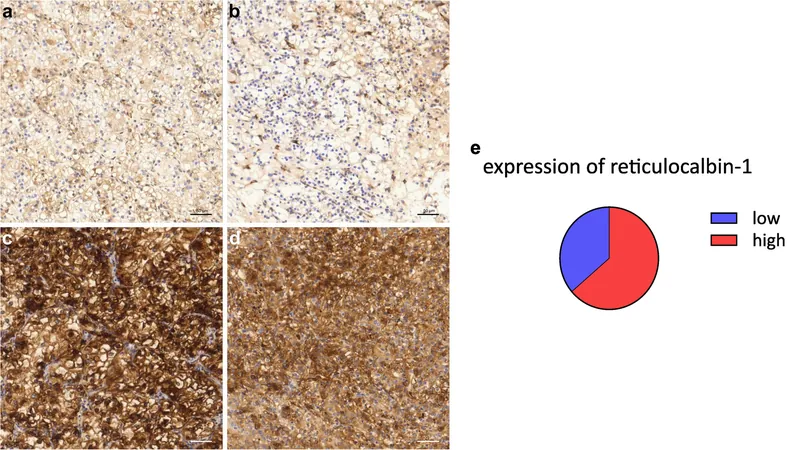
Unlocking the Secrets of Reticulocalbin-1: A Potential Game-Changer in Clear Cell Renal Cell Carcinoma
2025-09-20
Author: Nur
Introduction
Clear-cell renal cell carcinoma (ccRCC) ranks as the most common form of kidney cancer, with a grim prognosis, especially when metastasized. Despite ongoing advancements in treatment options, there is a pressing demand for better combination therapies and personalized treatment approaches.
The Power of Reticulocalbin-1
Enter Reticulocalbin-1 (RCN1), a protein located within the endoplasmic reticulum that's been linked to aggressive cancer behavior and poor patient outcomes across various solid tumors. However, its specific role in ccRCC has remained largely unexplored—until now.
Research Innovations
In a groundbreaking study, researchers utilized extensive transcriptomic data and conducted an analysis involving 306 patients from the University Hospital Bonn. Their aim? To uncover the correlation between RCN1 expression and vital clinicopathological parameters, as well as overall survival. The findings from this comprehensive cohort reflect significant trends regarding RCN1’s expression levels.
Key Findings: RCN1 as a Prognostic Indicator
Results indicated that RCN1 is not only prevalently expressed in ccRCC—hitting high levels in nearly 64% of studied tumors—but is also a clear marker of poor prognosis. Patients exhibiting high RCN1 levels were associated with a starkly shorter overall survival rate, as evidenced by statistical analyses. Higher RCN1 was further correlated with aggressive tumor characteristics such as elevated tumor grades, stages, and the presence of metastases.
Impact on Tumor Behavior
Delving deeper, the silencing of RCN1 via laboratory techniques exhibited a notable decrease in tumor cell migration and invasion, hinting at its potential role in promoting tumor aggressiveness. This paves the way for possible therapeutic interventions targeting RCN1.
The Bigger Picture: Kidney Cancer Statistics
To fully contextualize these findings, it’s essential to note that kidney cancer, particularly ccRCC, accounted for over 431,000 cases globally and over 179,000 deaths in 2020. The aggressive nature of ccRCC is highlighted by the fact that 20-30% of patients present with metastases at diagnosis—this percentage rises to 30-50% among those initially diagnosed with localized disease.
Shifting Treatment Paradigms
Treatment for metastatic ccRCC has evolved, incorporating a mix of molecular therapies and immune checkpoint inhibitors. However, innovative strategies, such as targeting RCN1, could redefine therapeutic options beyond traditional methods.
Conclusion: RCN1 as a Therapeutic Target
This landmark study brings RCN1 into the spotlight, positioning it as a potential biomarker for prognosis in ccRCC. With its capacity to significantly impact tumor behaviors and patient outcomes, RCN1 could be a strategic target for future therapeutic approaches, marking a promising horizon in the fight against kidney cancer.
The Way Forward
Future research will be crucial in confirming RCN1’s utility not just as a biomarker but also as a target for innovative treatment strategies. As scientists continue to unpack its role in cancer biology, RCN1 may very well herald a new era in ccRCC management.




 Brasil (PT)
Brasil (PT)
 Canada (EN)
Canada (EN)
 Chile (ES)
Chile (ES)
 Česko (CS)
Česko (CS)
 대한민국 (KO)
대한민국 (KO)
 España (ES)
España (ES)
 France (FR)
France (FR)
 Hong Kong (EN)
Hong Kong (EN)
 Italia (IT)
Italia (IT)
 日本 (JA)
日本 (JA)
 Magyarország (HU)
Magyarország (HU)
 Norge (NO)
Norge (NO)
 Polska (PL)
Polska (PL)
 Schweiz (DE)
Schweiz (DE)
 Singapore (EN)
Singapore (EN)
 Sverige (SV)
Sverige (SV)
 Suomi (FI)
Suomi (FI)
 Türkiye (TR)
Türkiye (TR)
 الإمارات العربية المتحدة (AR)
الإمارات العربية المتحدة (AR)